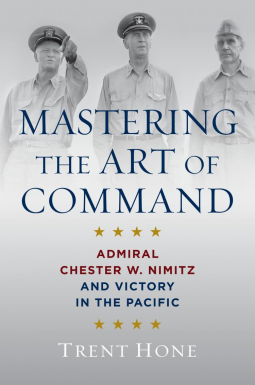
Mastering the Art of Command
Admiral Chester W. Nimitz and Victory in the Pacific
by Trent Hone
This title was previously available on NetGalley and is now archived.
Send NetGalley books directly to your Kindle or Kindle app
1
To read on a Kindle or Kindle app, please add kindle@netgalley.com as an approved email address to receive files in your Amazon account. Click here for step-by-step instructions.
2
Also find your Kindle email address within your Amazon account, and enter it here.
Pub Date Sep 15 2022 | Archive Date Jul 28 2022
Talking about this book? Use #MasteringtheArtofCommand #NetGalley. More hashtag tips!
Description
Mastering the Art of Command is a detailed examination of Admiral Chester W. Nimitz’s leadership during World War II. It describes how he used his talents to guide the Pacific Fleet following the attacks on Pearl Harbor, win crucial victories against the forces of Imperial Japan, and then seize the initiative in the Pacific. Once Nimitz’s forces held the initiative, they maintained it through an offensive campaign of unparalleled speed that overcame Japanese defenses and created the conditions for victory.
As a command and operational history, Mastering the Art of Command explores how Nimitz used his leadership skills, command talents, and strategic acumen to achieve these decisive results. Hone recounts how Nimitz, as both Commander-in-Chief of the Pacific Fleet (CINCPAC) and Commander-in-Chief of the Pacific Ocean Areas (CINCPOA), revised and adapted his organizational structure to capitalize on lessons and newly emerging information. Hone argues that Nimitz—because he served simultaneously as CINCPAC and CINCPOA—was able to couple tactical successes to strategic outcomes and more effectively plan and execute operations that brought victory at Midway, Guadalcanal, the Marshall Islands, the Philippines, Iwo Jima, and Okinawa.
As a study of leadership, uses modern management theories, and builds upon the approach in his award-winning Learning War. Trent Hone explores the challenge of leadership in complex adaptive systems through Nimitz’s behavior and causes us to reassess the inevitability of Allied victory and the reasons for its ultimate accomplishment. A new narrative history of the Pacific war, this book demonstrates effective patterns for complexity-informed leadership by highlighting how Nimitz maintained coherence within his organization, established the conditions for his subordinates to succeed, and fostered collaborative sensemaking to identify and pursue options more rapidly. Nimitz’s “strategic artistry” is a pattern worthy of study and emulation, for today’s military officers, civilian leaders, and managers in large organizations.
Available Editions
| EDITION | Hardcover |
| ISBN | 9781682475959 |
| PRICE | $39.95 (USD) |
Average rating from 7 members
Featured Reviews
 Evan L, Reviewer
Evan L, Reviewer
An interesting study of Nimitz in command, which couches much of its analysis in terms of modern business theory. Surprisingly, this works well. Some of the history is glossed over, so a good background on the Pacific war will enhance a reader’s experience. I found Hone’s examination of Nimitz’s ability to run Pacific Fleet and Pacific Ocean Area effective, as was his analysis of Nimitz’s collaborative style. Two stylistic elements that put me off was Hone’s willingness to say, without evidence, the Nimitz “almost certainly” behaved in some fashion in unrecorded meetings, and the frequent use of the phrase “sensemaking” , which I found to be jarring jargon. The best element for me was the contrast to MacArthur, which I would have liked to have seen explored even more deeply. Perhaps an article contrasting the two in the future?
Readers who liked this book also liked:
Kyle Thiermann
Biographies & Memoirs, Nonfiction (Adult), Parenting, Families, Relationships
Kristy Alpert
Children's Nonfiction, Outdoors & Nature, Travel
Sayuri Stabrowski
Children's Fiction, Outdoors & Nature, Parenting, Families, Relationships
Jessica L. Stevenson
Nonfiction (Adult), Parenting, Families, Relationships, Self-Help


















